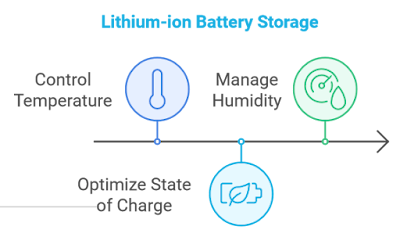Imagine your smartphone's battery, always ready to power your daily life. But have you ever wondered what happens when it's not in use? Lithium-ion cells, the heart of our portable devices, have a secret life when stored. In this article, we'll uncover how storage conditions impact their performance and what you can do to extend their lifespan.
The Storage Struggle
Lithium-ion cells are like any equipment – they need proper care to perform at their best. When stored, they face challenges that can affect their ability to hold a charge. Let's explore the key factors that impact their performance:
- Temperature Effects: Temperature plays a critical role in LIB performance. High temperatures can accelerate self-discharge, electrolyte degradation, and electrode material degradation, leading to capacity fade and increased internal resistance. Conversely, low temperatures can result in decreased ionic conductivity and sluggish charge transfer, hindering battery performance. Optimal storage temperatures typically range between 15°C and 25°C.
- State of Charge (SoC) Effects: The SoC at which LIBs are stored can significantly affect their long-term performance. Storing LIBs at high SoCs can lead to increased electrolyte oxidation and electrode material degradation, resulting in capacity loss. Conversely, storing LIBs at low SoCs can cause lithium plating, a safety hazard that can lead to internal short circuits. An SoC of around 50% is generally recommended for long-term storage.
- Humidity Effects: Humidity can have detrimental effects on LIBs. High humidity can lead to electrolyte leakage, corrosion, and interfacial reactions between the electrode materials and the electrolyte. This can result in capacity fade, increased internal resistance, and reduced battery life. Maintaining a low humidity environment is essential for preserving LIB performance.
The Ageing Process: What Happens Inside
As lithium-ion cells age, three main mechanisms affect their performance:
- Capacity Fade: Like a gradual memory loss, capacity fade reduces the cell's ability to store charge.
- Internal Resistance Increase: As the cell ages, internal resistance grows, slowing down charge transfer.
- Power Fade: The combination of capacity fade and internal resistance increase reduces the cell's ability to deliver power.
Best Practices for a Long and Happy Life
To keep your lithium-ion cells healthy and happy:
- Store them at room temperature (around 20°C)
- Maintain a moderate SoC level (around 50%)
- Keep them dry (below 60% relative humidity)
Conclusion
The performance and longevity of LIBs are significantly influenced by storage conditions. By optimizing storage temperature, SoC and humidity, you can enhance the performance and lifespan of LIBs. Remember, a well-stored lithium-ion cell is a happy cell!
More:
Articles:




Comments
Post a Comment